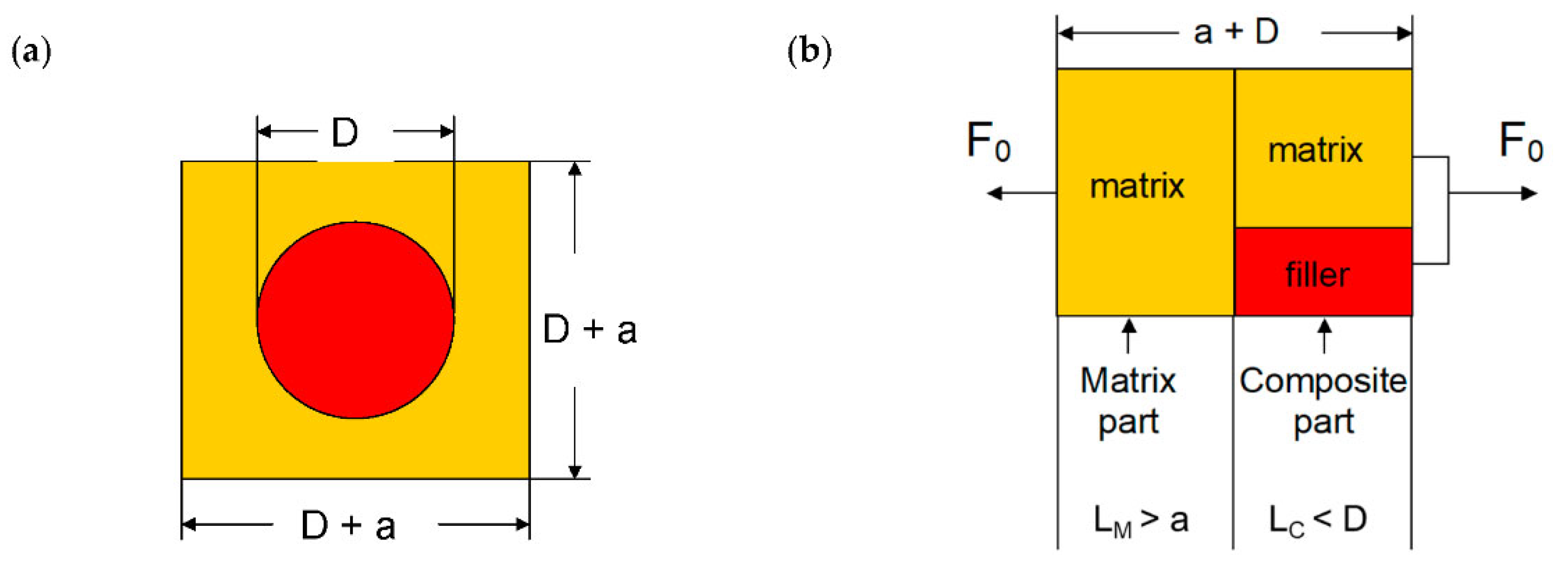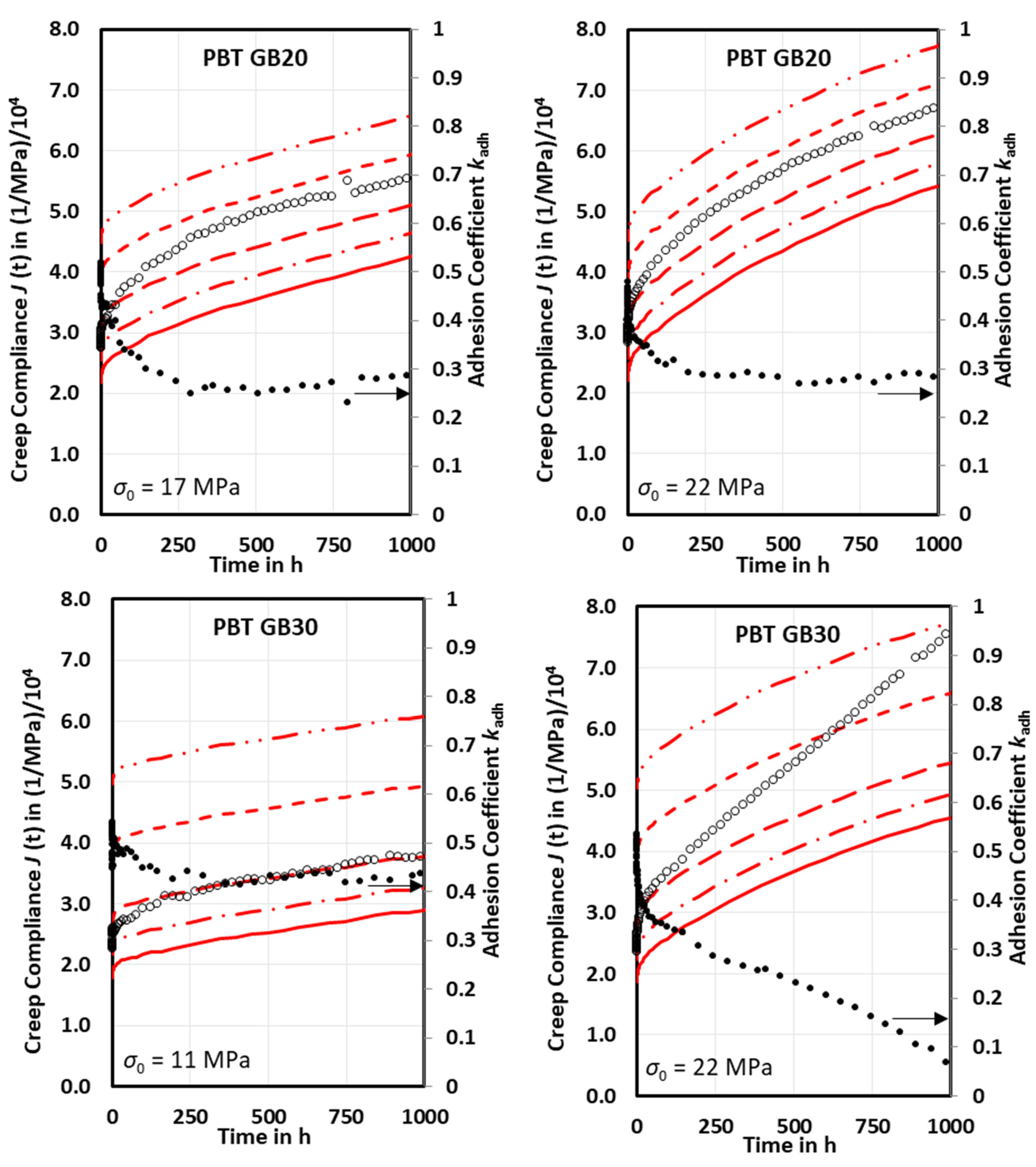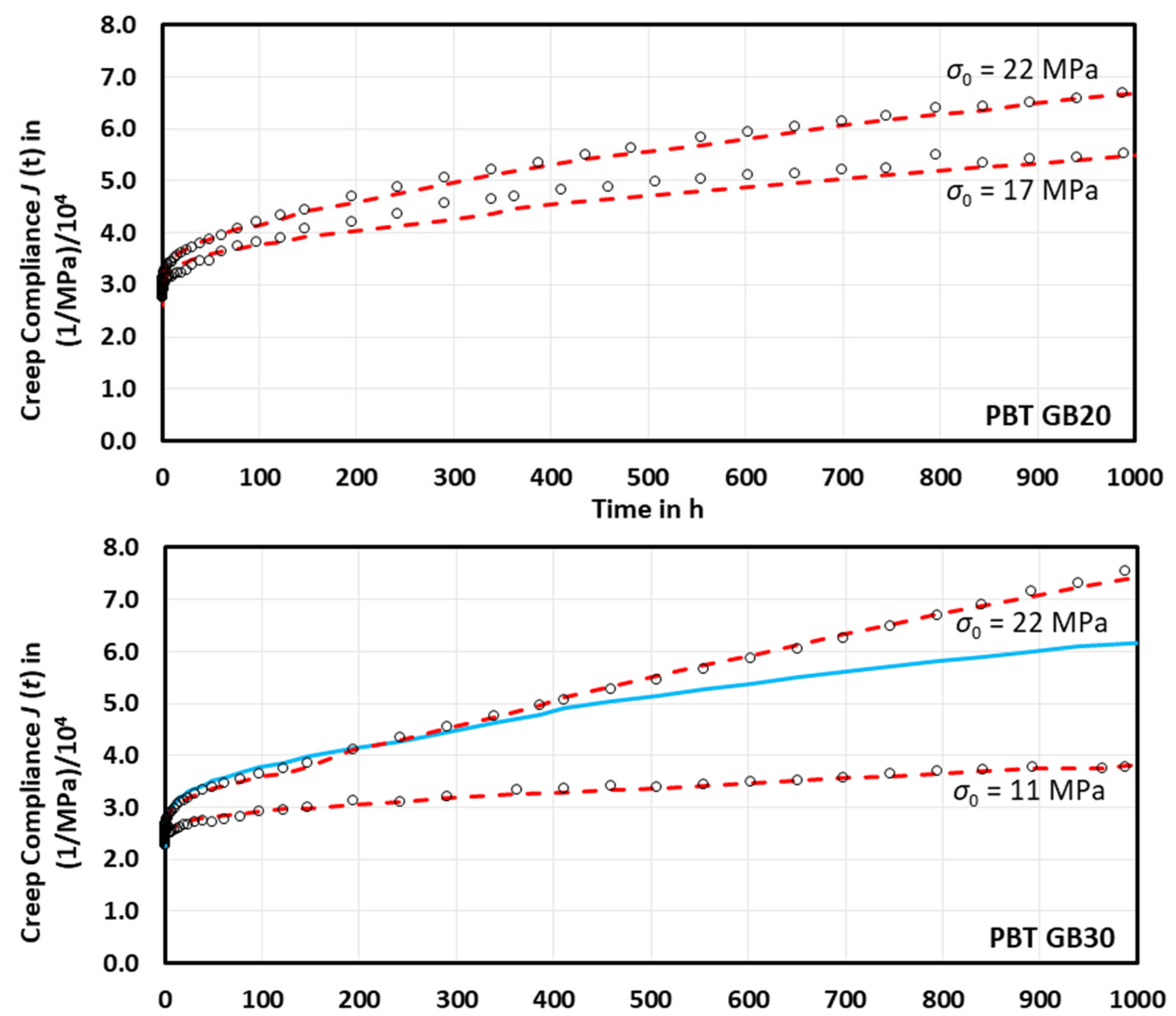Modeling of Creep Behavior of Particulate Composites with Focus on Interfacial Adhesion Effect
Abstract
1. Introduction
1.1. Rheological Models
1.2. Empirical Equations
2. Results and Discussion
2.1. Measured Creep Compliances and Their Fitting Using Burgers and Findley Models
2.2. Determination of the Time Dependent Compliance Function of Glass Beads Filled Composites
3. Materials and Methods
3.1. Materials
3.2. Methods
3.2.1. Creep Tests
3.2.2. Creep Modeling and Determination of Adhesion Factors
4. Conclusions
Author Contributions
Funding
Institutional Review Board Statement
Informed Consent Statement
Data Availability Statement
Conflicts of Interest
References
- Thomas, S. Polymer Composites; Wiley-VCH Verlag & Co.KgaA: Weinheim, Germany, 2012. [Google Scholar]
- Raghavan, J.; Meshii, M. Creep of polymer composites. Compos. Sci. Technol. 1998, 57, 1673–1688. [Google Scholar] [CrossRef]
- Fu, S.Y.; Feng, X.Q.; Lauke, B.; Mai, Y.W. Effects of particle size, particle/matrix interface adhesion and particle loading on mechanical properties of particulate-polymer composites. Compos. Part B-Eng. 2008, 39, 933–961. [Google Scholar] [CrossRef]
- Bek, M.; Aulova, A.; Cresnar, K.P.; Matkovič, S.; Kalin, M.; Perše, L.S. Long-term creep compliance of wood polymer composites: Using untreated wood fibers as a filler in recycled and neat polypropylene matrix. Polymers 2022, 14, 2539. [Google Scholar] [CrossRef] [PubMed]
- Chandekar, H.; Waigaonkar, S.; Chaudhari, V. Effect of chemical treatment on creep-recovery behavior of jute-polypropylene composites. J. Mater. Des. Appl. 2020, 235, 329–340. [Google Scholar] [CrossRef]
- Marcovich, N.E.; Villar, M.A. Thermal and mechanical characterization of linear low-density polyethylene/wood flour composites. J. Appl. Polym. Sci. 2003, 90, 2775–2784. [Google Scholar] [CrossRef]
- Findley, W.N.; Lai, J.S.; Onaran, K. Creep and Relaxation of Nonlinear Viscoelastic Materials; Dover Publication, Inc.: New York, NY, USA, 1989. [Google Scholar]
- Ediger, B. Einfluss der Teilchengeometrie auf das Verhalten von Verbundwerkstoffen mit Nicht-Linear-Viskoelastischen Eigenschaften, Dargestellt am Beispiel Gefüllten und Verstärkten Polypropylens. Ph.D. Thesis, Universität Stuttgart, Stuttgart, Germany, 1986. [Google Scholar]
- Ferry, J.D. Viscoelastic Properties of Polymers; John Wiley & Sons: New York, NY, USA, 1980. [Google Scholar]
- Altenbach, H. Classical and non-classical creep models. In Creep and Damage in Materials and Structures. International Centre for Mechanical Sciences; Altenbach, H., Skrzypek, J.J., Eds.; Springer: Vienna, Austria, 1999; Volume 399. [Google Scholar] [CrossRef]
- Cessna, L.C., Jr. Stress-time superposition of creep data for polypropylene and coupled glass-reinforced polypropylene. Polym. Eng. Sci. 1971, 11, 211–219. [Google Scholar] [CrossRef]
- Georgiopoulos, P.; Kontou, E.; Christopoulos, A. Short-term creep behavior of a biodegradable polymer reinforced with wood-fibers. Compos. Part B-Eng. 2015, 80, 134–144. [Google Scholar] [CrossRef]
- Eftekhari, M.; Fatemi, A. Creep behavior and modeling of neat, talc-filled, and short glass fiber reinforced thermoplastics. Compos. Part B-Eng. 2016, 97, 68–93. [Google Scholar] [CrossRef]
- Asyraf, M.R.M.; Ishak, M.R.; Sapuan, S.M.; Yidris, N. Comparison of Static and Long-term Creep Behaviors between Balau Wood and Glass Fiber Reinforced Polymer Composite for Cross-arm Application. Fibers Polym. 2021, 22, 793–803. [Google Scholar] [CrossRef]
- Gonilha, J.A.; Correia, J.R.; Branco, F.A. Creep response of GFRP–concrete hybrid structures: Application to a footbridge prototype. Compos. Part B-Eng. 2013, 53, 193–206. [Google Scholar] [CrossRef]
- Robinson, D.N.; Binienda, W.K.; Ruggles, M.B. Creep of polymer matrix composites. I: Norton/Bailey creep law for transverse isotropy. J. Eng. Mech.-ASCE 2003, 129, 310–317. [Google Scholar] [CrossRef]
- Buchdahl, R.; Nielsen, L.E. The application of Nutting´s equation to the viscoelastic behavior of certain polymeric systems. J. Appl. Phys. 1951, 22, 1344. [Google Scholar] [CrossRef]
- Simsiriwong, J.; Sullivan, R.W.; Hilton, H.H. Viscoelastic creep compliance using prony series and spectrum function approach. In Challenges in Mechanics of Time-Dependent Materials and Processes in Conventional and Multifunctional Materials; Antoun, B., Qi, H., Hall, R., Tandon, G., Lu, H., Lu, C., Eds.; Conference Proceedings of the Society for Experimental Mechanics Series; Springer: New York, NY, USA, 2013; Volume 2. [Google Scholar] [CrossRef]
- Preston, F.W. The mechanical properties of glass. J. Appl. Phys. 1942, 13, 623. [Google Scholar] [CrossRef]
- Xu, Y.; Wu, Q.; Young, L.; Yao, F. Creep behavior of bagasse fiber reinforced polymer composites. Bioresour. Technol. 2010, 101, 3280–3286. [Google Scholar] [CrossRef]
- CAMPUS Data Base. Available online: https://www.campusplastics.com/campus/en/datasheet/Ultradur%C2%AE+B+2550 (accessed on 18 October 2022).
- Perez, C.J.; Alvarez, V.A.; Vazquez, A. Creep behavior of layered silicate/starch-polycaprolactone blends nanocomposites. Mater. Sci. Eng. A-Struct. 2008, 480, 259–265. [Google Scholar] [CrossRef]
- Yang, J.; Zhang, Z.; Schlarb, A.K.; Friedrich, K. On the characterization of tensile creep resistance of polyamide 66 nanocomposites. Part II: Modeling and prediction of long-term performance. Polymer 2006, 47, 6745–6758. [Google Scholar] [CrossRef]
- Du, Y.; Yan, N.; Kortschot, M.T. An experimental study of creep behavior of lightweight natural fiber-reinforced polymer composite/honeycomb core sandwich panels. Compos. Struct. 2013, 106, 160–166. [Google Scholar] [CrossRef]
- Bourkas, G.; Prassianakis, I.; Kytopoulos, V.; Sideridis, E.; Younis, C. Estimation of elastic moduli of particulate composites by new models and comparison with moduli measured by tension, dynamic and ultrasonic tests. Adv. Mat. Sci. Eng. 2010, 2010, 891824. [Google Scholar] [CrossRef]
- Paul, B. Prediction of constants of multiphase materials. Trans. Am. Inst. Min. Metall. Pet. Eng. 1960, 218, 36–41. [Google Scholar]
- Ishai, O.; Cohen, I.J. Elastic properties of filled and porous epoxy composites. Int. J. Mech. Sci. 1967, 9, 539–546. [Google Scholar] [CrossRef]
- Rech, J. Introduction of an adhesion factor to cube in cube models and its effect on calculated moduli of particulate composites. Sci. Rep. 2022, 12, 1–14. [Google Scholar] [CrossRef] [PubMed]
- Pöllet, P. Automatisierte Zeitstandsmessung—Verfahren mit berührungsloser Dehnungsmessung. Kunststoffe 1985, 75, 829–834. [Google Scholar]
- Möginger, B. Einfluss der Verarbeitung auf Morphologie und Deformationsverhalten von Polybutylen-Terephthalat (PBT)—Appendix B. Ph.D. Thesis, University of Stuttgart, Stuttgart, Germany, 1993. [Google Scholar]




| Models | Creep Strain/Creep Compliance | |
|---|---|---|
| Burgers | (1) | |
| with time t, initial stress σ0, stiffnesses of Burgers model E1, E2 and viscosities of Burgers model η1, η2 | ||
| Modified Burgers | (2) | |
| with relaxation time τ and fitting parameters a and b | ||
| Findley power law | (3) | |
| with initial strain ε0, transient strain ε+, exponent n, reference time t1 | ||
| Findley modified power law | (4) | |
| with reference stress σ1 | ||
| Bailey–Norton | (5) | |
| with coefficient A and exponents m and n+ | ||
| Power series | (6) | |
| with reference time t’, relaxation strengths Ji and index i | ||
| Prony–Dirichlet series | (7) | |
| with relaxation times τi | ||
| with relaxation times τi |
| Range of Fitting Time | GB Content | Initial Stress σ0 | Parameters of Burgers Model | |||
|---|---|---|---|---|---|---|
| E1 | E2 | η1 | η2 | |||
| h | w% | MPa | MPa | GPa h | ||
0 to 250 | 0 | 11 | 2720 | 21,900 | 3170 | 115 |
| 17 | 2620 | 21,340 | 1680 | 92 | ||
| 22 | 2570 | 15,900 | 1090 | 74 | ||
| 20 | 17 | 3540 | 28,100 | 1750 | 108 | |
| 22 | 3380 | 18,890 | 1530 | 66 | ||
| 30 | 11 | 4220 | 35,940 | 4490 | 174 | |
| 22 | 4080 | 18,770 | 1590 | 47 | ||
| 0 to 1000 | 0 | 11 | 2710 | 19,160 | 4480 | 219 |
| 17 | 2600 | 14,160 | 2840 | 141 | ||
| 22 | 2560 | 10,684 | 1660 | 128 | ||
| 20 | 17 | 3500 | 24,100 | 3310 | 123 | |
| 22 | 3340 | 18,500 | 2370 | 86 | ||
| 30 | 11 | 4180 | 23,740 | 9110 | 384 | |
| 22 | 4060 | 15,910 | 2120 | 64 | ||
| Range of Fitting Time | GB Content | Initial Stress σ0 | Parameters of Findley Power Law Model | |||
|---|---|---|---|---|---|---|
| ε0 | ε+ | n | E1 = σ0/ε0 | |||
| h | w% | MPa | 10−2 | 10−6 | - | MPa |
| 0 to 250 | 0 | 11 | 0.41 | 2.21 | 0.47 | 2690 |
| 17 | 0.64 | 2.54 | 0.52 | 2657 | ||
| 22 | 0.86 | 3.40 | 0.55 | 2545 | ||
| 20 | 17 | 0.47 | 8.73 | 0.42 | 3629 | |
| 22 | 0.62 | 8.36 | 0.46 | 3529 | ||
| 30 | 11 | 0.27 | 7.58 | 0.35 | 4149 | |
| 22 | 0.56 | 6.23 | 0.48 | 3907 | ||
| 0 to 1000 | 0 | 11 | 0.41 | 2.23 | 0.47 | 2666 |
| 17 | 0.64 | 2.54 | 0.52 | 2657 | ||
| 22 | 0.86 | 3.41 | 0.55 | 2546 | ||
| 20 | 17 | 0.47 | 9.06 | 0.42 | 3636 | |
| 22 | 0.62 | 8.36 | 0.46 | 3526 | ||
| 30 | 11 | 0.26 | 8.02 | 0.35 | 4165 | |
| 22 | 0.56 | 6.63 | 0.48 | 3929 | ||
| Range of Fitting Time | GB Content | Initial Stress | Fit Parameter of Time-Dependent Adhesion Factor | ||
|---|---|---|---|---|---|
| σ0 | [Δk]_adh | R2 | |||
| h | w% | MPa | - | - | % |
| 0 to 250 | 20 | 17 | 0.017 | 0.45 | 95.2 |
| 22 | 0.016 | 0.41 | 99.4 | ||
| 30 | 11 | 0.008 | 0.49 | 92.4 | |
| 22 | 0.021 | 0.45 | 99.0 | ||
| 0 to 1000 | 20 | 17 | 0.022 | 0.45 | 94.6 |
| 22 | 0.017 | 0.41 | 99.3 | ||
| 30 | 11 | 0.009 | 0.49 | 92.5 | |
| 22 | 0.027 | 0.44 | 97.9 | ||
| ln | 0 < t < 150 h | 0.020 | 0.45 | 99.4 | |
| lin | 150 h < t < 1000 h | 0.123 | 0.97 | 99.6 | |
| Weight Content of Glass Bead | Volume Content of Glass Bead | Young’s Modulus | Tensile Strength | Elongation at Tensile Strength |
|---|---|---|---|---|
| vF | vF | E | σmax | εmax |
| - | - | MPa | MPa | % |
| 0 | 0 | 2754 ± 25 | 59 ± 0.1 | 10.8 ± 1.4 |
| 20 | 0.12 | 3691 ± 33 | 57 ± 0.1 | 3.2 ± 0.2 |
| 30 | 0.19 | 4408 ± 39 | 55 ± 0.1 | 2.0 ± 0.6 |
Publisher’s Note: MDPI stays neutral with regard to jurisdictional claims in published maps and institutional affiliations. |
© 2022 by the authors. Licensee MDPI, Basel, Switzerland. This article is an open access article distributed under the terms and conditions of the Creative Commons Attribution (CC BY) license (https://creativecommons.org/licenses/by/4.0/).
Share and Cite
Rech, J.; Ramakers-van Dorp, E.; Möginger, B.; Hausnerova, B. Modeling of Creep Behavior of Particulate Composites with Focus on Interfacial Adhesion Effect. Int. J. Mol. Sci. 2022, 23, 14120. https://doi.org/10.3390/ijms232214120
Rech J, Ramakers-van Dorp E, Möginger B, Hausnerova B. Modeling of Creep Behavior of Particulate Composites with Focus on Interfacial Adhesion Effect. International Journal of Molecular Sciences. 2022; 23(22):14120. https://doi.org/10.3390/ijms232214120
Chicago/Turabian StyleRech, Julian, Esther Ramakers-van Dorp, Bernhard Möginger, and Berenika Hausnerova. 2022. "Modeling of Creep Behavior of Particulate Composites with Focus on Interfacial Adhesion Effect" International Journal of Molecular Sciences 23, no. 22: 14120. https://doi.org/10.3390/ijms232214120
APA StyleRech, J., Ramakers-van Dorp, E., Möginger, B., & Hausnerova, B. (2022). Modeling of Creep Behavior of Particulate Composites with Focus on Interfacial Adhesion Effect. International Journal of Molecular Sciences, 23(22), 14120. https://doi.org/10.3390/ijms232214120






